Spectrophotometry

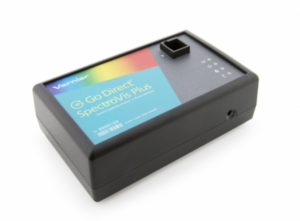
Vernier GoDirect Spectrophotometer and SVIS Plus Flurometer
The Go Direct SpectroVis Plus GDX-SVISPL spectrophotometer quickly measures a full wavelength spectrum.
Designed specifically for education applications, the SpectraVis Plus connects directly wirelessly via Bluetooth® or via cable via USB to your platform (Computer, Tablet, Mobile or Vernier Labquest 2 interface).
To use the Go Direct SpectroVis Plus spectrophotometer, download our free Spectral Analysis app. The app is compatible with computers, Chromebooks, and mobile devices. Students can also connect to LabQuest 2 or a computer running Logger Pro to perform analysis.
This device can easily collect a full wavelength spectrum (absorbance, percent transmission, or intensity) in less than a second. Once the peak wavelength is determined, the concentration of a solution can be established (Beer’s Law) or rates of reactions can be monitored. A low light path allows the SpectroVis Plus Go Direct spectrophotometer to be used for micro-scale laboratories and biochemistry applications with micro and semi-micro cuvettes. The Spectrovis plus Go Direct Spectrometer can be used in a variety of experiments:
For a more detailed emissions analysis, consider the Vernier Emissions Spectrometer.
|
What do you need to use the SVIS Plus Spectrophotometer?
This equipment can be connected via USB or Bluetooth and the app on your computer or mobile device is free so you do not need to purchase additional software.
If you wish, you can also connect the Vernier Labquest 2 in case you do not want to work with your computer or Chromebook, Android, or iOS mobile device.

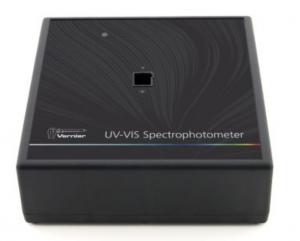
UV-VIS Vernier Spectrometer
The UV-VIS Vernier is an easy and accurate ideal instrument for measuring the absorption spectra of various chemical and biochemical compounds. An (additional) fiber optic accessory can be connected to the spectrometer for light emission spectrum experiments. It has a USB interface that allows you to connect it directly to your computer or LabQuest for data collection.
Dimensiones: 18,5 cm x 17,0 cm x 7,0 cm
Power supply: AC power adapter (included)
Power Consumption: 3 A at startup, 500 mA continuous
Light source: deuterium (UV) and incandescent (VIS)
Detector: Linear CCD
Wavelength range: 220-850 nm
Wavelength Reporting Interval: ~1 nm
Optical resolution: 3.0 nm (determined with the 486 nm FWHM hydrogen emission spectral line)
Wavelength Accuracy: ± 2.0 nm (determined with the NIST Holmium Oxide standard)
Photometric Accuracy: ±5.0% (as determined using NIST Potassium Dichromate standards)
Photometric range (for accuracy): 0.1-1.0
Typical scan duration: ~ 2 s
Operating temperature: 15 to 35 ° C
What do you need to use the UV-VIS Spectrometer?
This equipment can be connected via USB and the Spectral Analysis app on your computer is free so you do not need to purchase additional software.
If you wish, you can also connect the Vernier Labquest 2 in case you do not want to work with your computer.

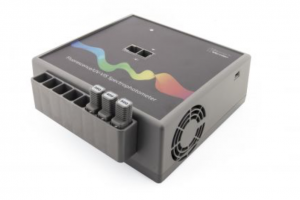
Fluorescence and UV-VIS Vernier Spectrophotometer
The UV-VIS / Fluorescence Spectrophotometer measures the absorbance and fluorescence spectra of various chemical and biochemical compounds.
It is specifically designed for upper level chemistry courses. We have combined the functionality of a fluorometer with the power of a UV/VIS spectrophotometer to enable students to easily and accurately carry out numerous fluorescence experiments with compounds such as quinine sulfate, DAPI, GFP, and tryptophan. Interchangeable LEDs make sure you get the exact excitation wavelength needed for your experiment. To carry out emission spectral experiments simply plug in the Fiber Optic Vernier Spectrophotometer.
Fluorescence/UV-VIS connects directly to a computer or LabQuest. Data can be collected and analyzed using our Logger Pro software, so there is no need to train students in other instrument software.
- Detection modes: absorbance and fluorescence.
- Dimensions: 18.5cm x 17.0cm x 7.0cm.
- Power supply: AC adapter (included).
- Power consumption: 3 A start-up, 500 mA continuous.
- Light source absorbance: deuterium (UV) and incandescent (VIS).
- Emitting Light Source: Switchable LED (ships with 375nm, 450nm, 525nm).
- Detector: linear CCD.
- Wavelength range: 220-850 nm.
- Wavelength reporting interval: ~ 1 nm.
- Optical resolution: 3.0 nm (as determined with 486 nm hydrogen emission spectral line FWHM).
- Precision Wavelength: ± 2.0 nm (determined using the NIST Holmium Oxide standard).
- Photometric Accuracy – Absorbance: ± 5.0% (as determined by NIST Potassium Dichromate standards).
- Absorbance photometric range (for accuracy): 0.1-1.0.
- Typical cycle time: ~ 2 s.
- Sample format: 10 mm × 10 mm cuvette (UV fluorescence cuvette included).
- Fluorescence emission detection limit: 1 mg/L quinine sulfate dihydrate in 0.1 MH 2 SO 4.

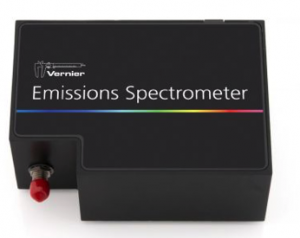
Emission Spectrometer
Use the Vernier Emissions Spectrometer to perform the emissions analysis. It gives precise measurements in a range of 350-900 nm to examine the spectra of light bulbs, spectrum tubes, or the sun.
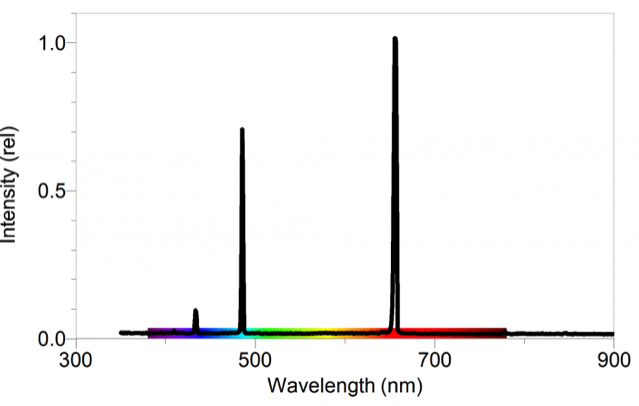
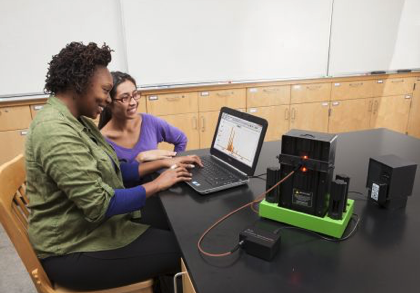
This is the perfect tool to carry out emissions analysis. The Vernier Emissions Spectrometer allows you to instantly collect emission spectra from light bulbs, gas discharge tubes, or the sun. It connects directly to your computer or LabQuest with a standard USB cable and provides accurate measurements in the 350-900 nm range.
It is recommended to use the Vernier Emissions Spectrometer without an optical fiber to measure the spectra of large sources, such as the sun, or to compare types of light bulbs.
An optical fiber is recommended for the analysis of emissions from a gas spectrum tube.

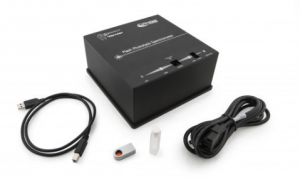
Photolysis Spectrometer
The Flash Photolysis Vernier Spectrometer is a simple, easy-to-use device for demonstrating the fundamental principles of chemical and photochemical kinetics to higher education chemistry students. It measures the absorption and emission changes over time of a sample photoexcited at a single wavelength, which is determined by a filter (600 nm filter included)
- Spectral coverage: 450-750 nm
- Temporal resolution: 100 microseconds
- Spectral resolution: Determined by the interference filter used (10 nm with the included 600 nm interference filter)
- Minimum time window: 15 milliseconds
Photochemical reactions are very important in many areas of chemistry with applications including photodynamic therapy and solar energy harvesting. These reactions often proceed rapidly and, as a result, require fast reaction techniques to analyze. The Vernier Flash Photolysis Spectrometer is a simple, easy-to-use transient absorption spectrometer. It is useful for demonstrating the fundamental principles of such fast, photo-catalyzed reactions. Some experiment ideas include kinetics of photochemical reactions like
- excited state dynamics.
- Triplet decay analysis.
- time resolved phosphorescence.
- kinetics of quenching phosphorescence.
- isomerization.
- Reactive free radicals.
- photocatalysis.
What’s Include
- Vernier Flash Photolysis Spectrometer
- AC power supply
- A fluorescence quartz cuvette
- USB Cable
- Empty filter housing (fits standard size, 3rd party filters: 12.5mm OD and 9.0mm ID)
600 nm filter (10 nm FWHM) in the filter housing - Quick Start Guide
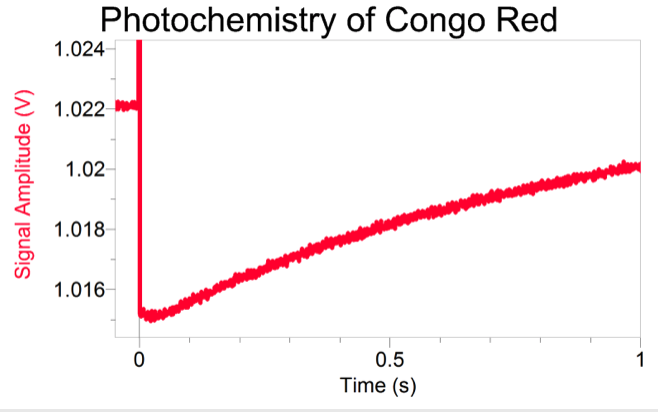
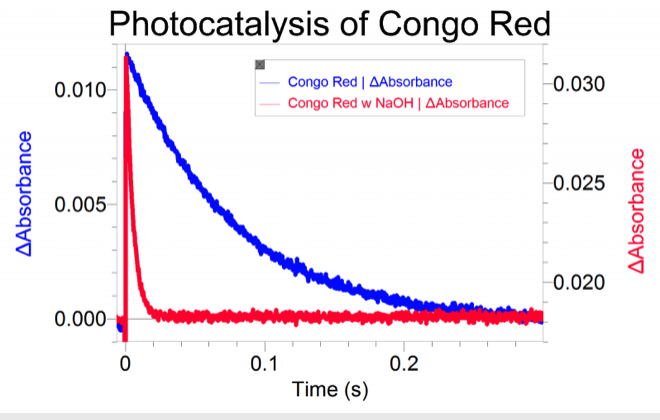
Request an official quote:
Spectrophotometry Spectrophotometry Spectrophotometry Spectrophotometry Spectrophotometry Spectrophotometry Spectrophotometry Spectrophotometry Spectrophotometry Spectrophotometry Spectrophotometry
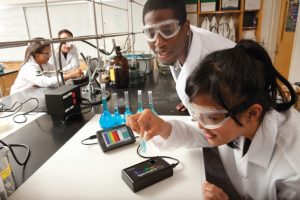
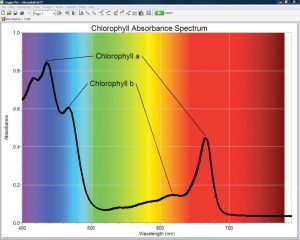 Specifications
Specifications